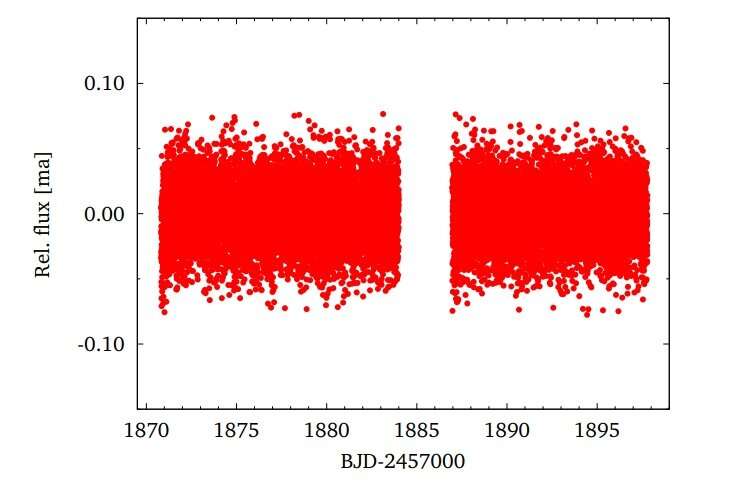Light curve of GD 99 obtained by TESS. Credit: Bognár et al, 2022
Using the 1-m Ritchey–Chrétien–Coudé telescope of the Konkoly Observatory in Budapest, Hungary and NASA's Transiting Exoplanet Survey Satellite (TESS), Hungarian astronomers have observed a variable star known as GD 99. Results of the study, published November 21 on the arXiv pre-print server, shed more light on the properties of this variable.
Detecting and studying variable stars could offer important hints into aspects of stellar structure and evolution. Investigation of variables could be also helpful for a better understanding of the distance scale of the universe.
ZZ Ceti stars (also known as DAV stars), are variables with modest luminosity variations and periods between 30 and 1,200 seconds. They are pulsating white dwarfs of type DA, which have a pure hydrogen outer layer composition.
GD 99 is one of the brightest ZZ Ceti stars known to date. However, although GD 99 was identified as a variable white dwarf almost half a century ago, its pulsating behavior and asteroseismology have not been comprehensively studied yet. In order to change this, a team of astronomers from the Konkoly Observatory, led by Zsófia Bognár, has carried out long-term, single-site observations of GD 99 with the main goal of performing a seismic analysis of this star.
"We selected GD 99 for a long-time ground-based follow-up measurement, which resulted in 30 nights of observations, spanning more than 119 observing hours.... We performed observations between 2002 and 2022 with the 1-m Ritchey–Chrétien–Coudé telescope at the Piszkésteto mountain station of Konkoly Observatory, Hungary.... TESS observed GD 99 for 27.4 days in sector 21 with the 120-second short-cadence mode between January 21, and February 18, 2020," the researchers wrote in the paper.
The observations allowed the team to identify 11 eigenmodes for seismology. It was found that GD 99 in general is rich in pulsation modes in the 200–1,100 s period range, given that the astronomers detected seven new periods.
Based on the results, the astronomers were able to determine fundamental parameters of GD 99. The mass of the star was calculated to be about 0.8 solar masses and its effective temperature was estimated to be at a level of 13,500 K. It turned out that the star is located some 110 light years away and its rotation period is approximately 13.17 hours.
By comparing the results with earlier studies, GD 99 is hotter, more massive and located nearer than previously thought. The authors of the paper assume that the star may be at the blue edge of the empirical ZZ Ceti instability strip—a region of the Hertzsprung–Russell diagram largely occupied by several related classes of pulsating variables.
All in all, the researchers underlined that GD 99 joins the currently small group of known white dwarf pulsators rich in oscillation modes.
More information: Zs. Bognár et al, GD 99: Re-investigation of an old ZZ Ceti companion, arXiv (2022). DOI: 10.48550/arxiv.2211.11676
Journal information: arXiv
© 2022 Science X Network
























